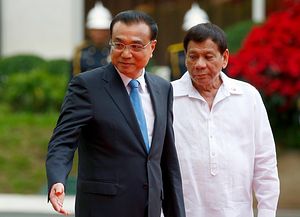The China-Philippines relationship has completely thawed,becoming as warm as Manila’s weather, according to Chinese Premier Li Keqiang.
Li paid an official visit to the Philippines from November 15 to 16, after the country concluded its hosting of the Association of Southeast Asian Nations (ASEAN) summit in Manila. Li was the first Chinese premier in ten years to visit the Philippines. As The Diplomat reported earlier, China’s foreign ministry attached great important to Li’s visit, issuing a round of publicity ahead of the trip and praising the warming relationship on multiple occasions.
On November 15, Li and Philippine President Rodrigo Duterte co-hosted a press conference after their meeting at Malacañang Palace.
According to China’s state news agency Xinhua as well as the Philippines’ The Philippine Star, Li told the press:
Winter has come to the Northern Hemisphere but the temperature in Manila is still running pretty high. I think that somewhat reflects the temperature of Philippine-China relations, which is also going pretty high on the basis of the positive improvement of the relations between the two countries. We hope that we will continue to work together to strengthen this positive momentum and work together for the time that we may have lost.
China and the Philippines also issued a joint statement on November 16. According to the statement, both sides recognize that the bilateral relations have “achieved positive turnaround” and agree to “advance Philippines-China relations in a sustained and pragmatic manner.”
Regarding the South China Sea dispute — the problem that has seriously undermined mutual relations in the past — there are three lengthy paragraphs in the statement related to the issue. “Both sides affirm that contentious maritime issues are not the sum total of the Philippines-China bilateral relationship,” the statement said.
Both sides agreed to strengthen maritime cooperation in areas such as marine environmental protection, disaster risk reduction, and possible cooperation in marine scientific research, subject to further consultations. Both countries may also “explore means to cooperate” in other possible maritime activities, including maritime oil and gas exploration and exploitation.
Notably, both countries also “reaffirm the importance of maintaining and promoting regional peace and stability, freedom of navigation in and over-flight above the South China Sea, as well as freedom of commerce and other peaceful uses.”
The joint statement is a far cry from the tense standoff between China and the Philippines over the South China Sea under the previous Philippine president. Notably, former President Benigno Aquino III’s administration filed an international arbitration case against China’s claims and behavior in the South China Sea, despite Beijing’s vehement protests. Duterte, however, has taken a more low-key stance on the disputes in the hopes of securing financial gains for his country.
We saw the results during Li’s visit, when China signed 14 agreements with the Philippines, furthering the economic side of the relationship.
For example, China will provide a RMB150 million ($23 million) grant to help with reconstruction in battle-ravaged Marawi City. The Export-Import Bank of China has also signed a $307.41 million financing agreement with the Philippines for the construction of the Kaliwa Dam-New Centennial Water Source project and the Chico River Pump Irrigation Facility.
Ahead of Li’s trip to Manila, Li published a signed article in the Philippines’ newspapers, expressing China’s strong intention to renew friendship with the nation. In the article, Li highly praised Duterte for making “the right decision to improve and develop relations with China” since Duterte took office.
“The China-Philippines relationship is now seeing a rainbow after the storm and showing a good momentum across the board,” the article said.

































